Section 1.1 Section 1.2 Section 1.3 - The Student Room
Section 1.1 Section 1.2 Section 1.3 - The Student Room
Section 1.1 Section 1.2 Section 1.3 - The Student Room
Create successful ePaper yourself
Turn your PDF publications into a flip-book with our unique Google optimized e-Paper software.
SECTION 4<br />
<strong>Section</strong> 4.4<br />
1 <strong>The</strong> entropies increase for the first four alkanes as the<br />
molecules become heavier and composed of more atoms<br />
(the number of energy levels increases with the number<br />
of atoms). Pentane is a liquid and so has a lower entropy<br />
than butane.<br />
2 a Entropy decrease, because the number of moles of gas<br />
is reduced by half as reaction proceeds.<br />
b Entropy increase; the number of moles of gas doubles<br />
during the reaction and a solid has much lower<br />
entropy than a gas.<br />
c Entropy decrease; 2 moles of gaseous reactants are<br />
replaced by 1 mole of solid.<br />
d Entropy decrease; 5 moles of gaseous oxygen are<br />
removed, the only product is a solid.<br />
e Entropy increase; 5 moles of gaseous product are<br />
formed.<br />
<strong>Section</strong> 4.5<br />
1 a When 1 mole of sodium fluoride is formed from 1 mole<br />
of Na + (g) and 1 mole of F – (g), 915 kJ mol –1 of energy are<br />
released. This is the lattice enthalpy of sodium fluoride.<br />
b <strong>The</strong> lattice enthalpy becomes more negative as the<br />
ionic radii decrease.<br />
2 a LiF; Li + has a smaller radius than Na + and attracts F –<br />
ions more strongly.<br />
b Na 2<br />
O; Na + has a smaller radius than Rb + and attracts<br />
O 2– more strongly.<br />
c MgO; Mg 2+ is smaller and more highly charged than<br />
Na + , and attracts O 2– more strongly.<br />
d KF; F – has a smaller radius than Cl – and attracts K +<br />
more strongly.<br />
3 a SrF 2<br />
; Sr 2+ is smaller and more highly charged than Rb +<br />
and will attract F – more strongly.<br />
b By the same arguments as in a, BaO should have the<br />
more exothermic lattice enthalpy.<br />
c Cu 2+ is more highly charged than Cu + , so CuO should<br />
have the more exothermic lattice enthalpy.<br />
4 a Li + attracts water molecules more strongly than Na +<br />
because of its smaller size.<br />
b Mg 2+ attracts water molecules more strongly than<br />
Ca 2+ because of its smaller size.<br />
c Ca 2+ and Na + have similar sizes, but Ca 2+ is more highly<br />
charged and so attracts water molecules more strongly.<br />
5 a <strong>The</strong> ions in the lattice attract each other less strongly<br />
as the size of the anion increases from F – to Cl – .<br />
b DH hyd<br />
becomes less exothermic as the anion becomes<br />
bigger and attracts water molecules less strongly.<br />
c<br />
AgF(s) + aq<br />
–DH LE<br />
DH solution<br />
Ag + (g) + F – (g) + aq<br />
Ag + (aq) + F – (aq)<br />
DH hyd<br />
(Ag + )<br />
+<br />
DH hyd<br />
(F – )<br />
3 <strong>Student</strong>s’ answers should be based on the following<br />
deductions.<br />
a<br />
b<br />
c<br />
d<br />
e<br />
DS sys<br />
DS surr<br />
Explanation<br />
/J K –1 mol –1 /J K –1 mol –1<br />
+203 –44 Spontaneous: total<br />
entropy change positive<br />
+63 +329 Spontaneous: total<br />
entropy change positive<br />
+25 –604 Not spontaneous: total<br />
entropy change negative<br />
+209 +416 Spontaneous: total<br />
entropy change positive<br />
–4 –6.7 Not spontaneous: total<br />
entropy change negative<br />
4 Values for both DS sys<br />
and DS surr<br />
are negative. <strong>The</strong>refore<br />
DS total<br />
must always be negative, whatever value of T is<br />
chosen, and the process can never be spontaneous.<br />
Enthalpy<br />
AgCl(s) + aq<br />
–DH LE<br />
DH solution<br />
Ag + (g) + Cl – (g) + aq<br />
Ag + (aq) + Cl – (aq)<br />
DH hyd<br />
(Ag + )<br />
+<br />
DH hyd<br />
(Cl – )<br />
Both silver halides have endothermic enthalpy<br />
changes of solution and the enthalpy level diagrams<br />
will have the form shown below.<br />
–DH LE<br />
AgX(s) + aq<br />
Ag + (g) + X – (g) + aq<br />
Ag + (aq) + X – (aq)<br />
DH solution<br />
d DH solution<br />
= –DH LE<br />
+ DH hyd<br />
(Ag + ) + DH hyd<br />
(X – )<br />
DH solution<br />
(AgF) = +6 kJ mol –1 ;<br />
DH solution<br />
(AgCl) = +95 kJ mol –1<br />
DH hyd (Ag + )<br />
+<br />
DH hyd (X – )<br />
e AgF may be soluble in water. AgCl will be insoluble.<br />
6 a Mg(OH) 2<br />
+ 152 kJ mol –1<br />
Ca(OH) 2<br />
+ 7 kJ mol –1<br />
b Ca(OH) 2<br />
: enthalpy change of solution much less<br />
endothermic.<br />
c Entropy changes of the processes.<br />
171


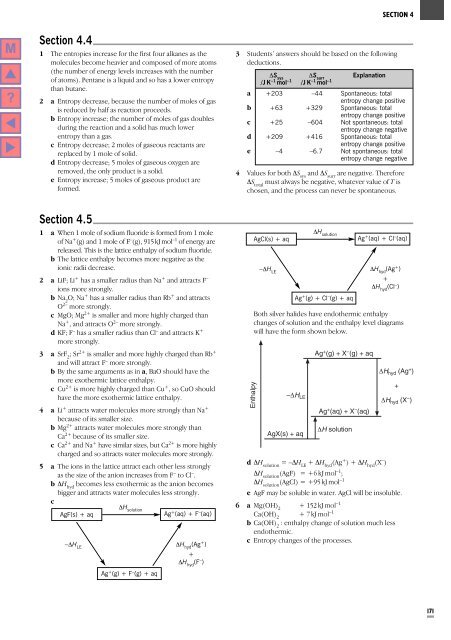
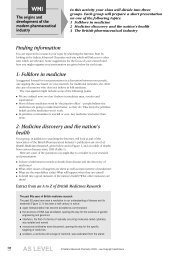
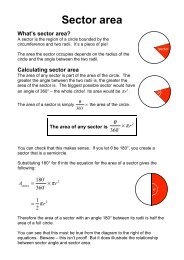
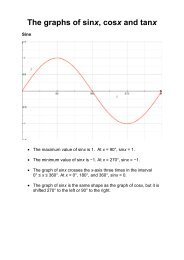
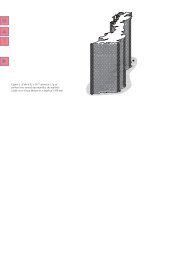

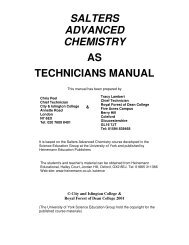


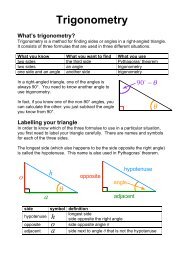
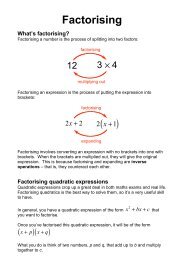
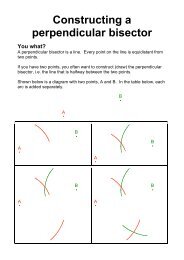


![ISI Web of Knowledge [v.4.10] - All Databases Results - Benjamin-Mills](https://img.yumpu.com/39253071/1/184x260/isi-web-of-knowledge-v410-all-databases-results-benjamin-mills.jpg?quality=85)